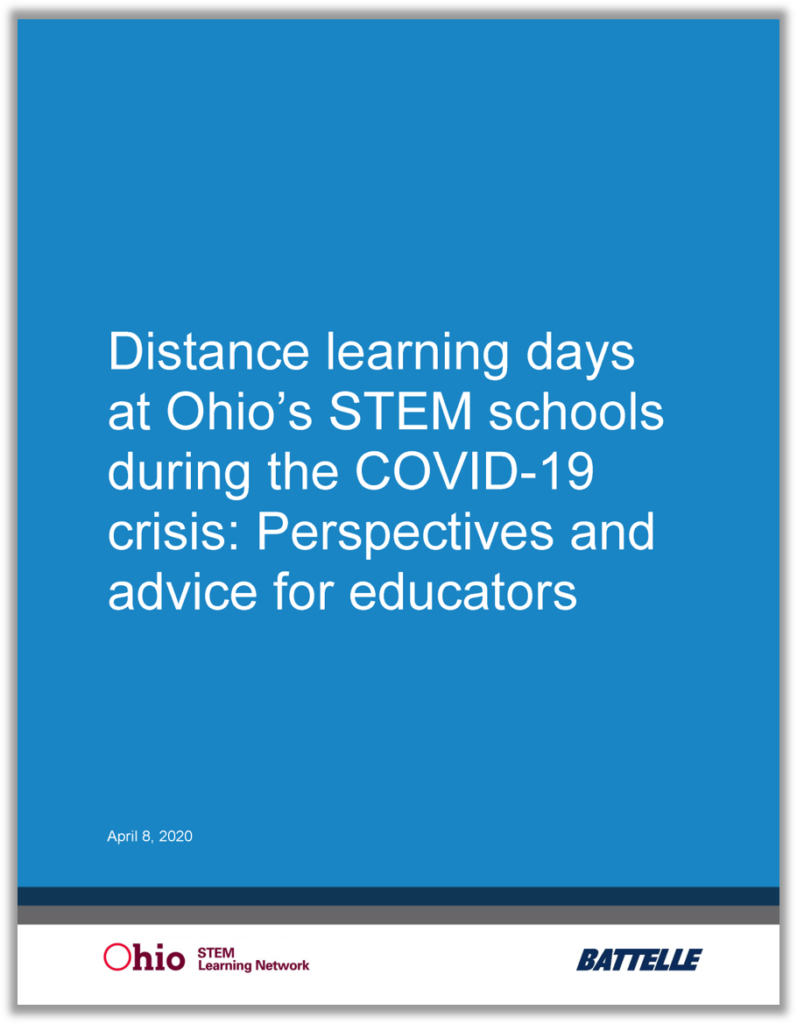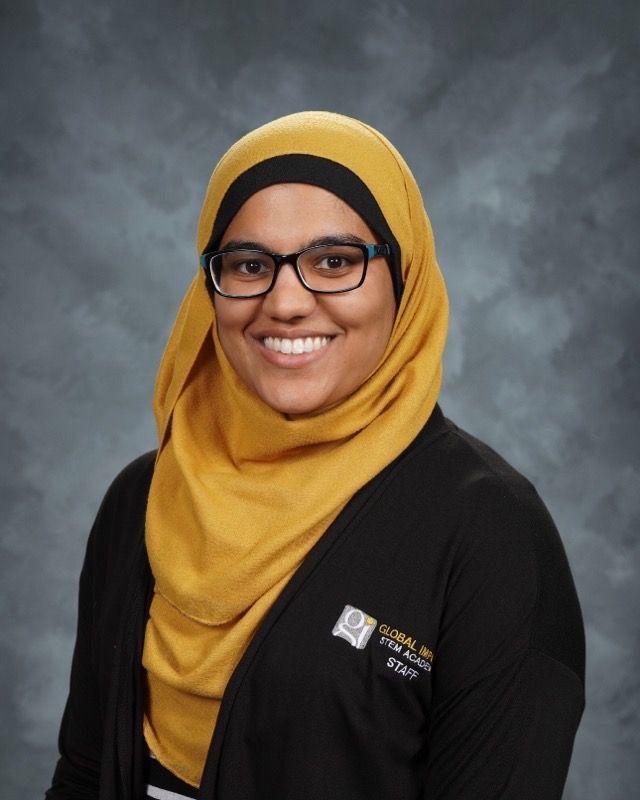Ohio schools, from pre-K to college, are closed during the COVID-19 pandemic, forcing students and teachers to adapt to online instruction. This method is new to many involved, and there was no time to prepare for the abrupt change, causing confusion and anxiety.
Ohio’s community of educators is strong, with many teachers sharing their advice with each other. Today, we release a new report: “Distance learning days at Ohio’s STEM schools during the COVID-19 crisis: Perspectives and advice for educators.” The report pulls together information from more than a dozen different Ohio STEM Learning Network schools. Download it here.
 We also wanted to take a more personal look at how educators are adapting. Some schools, because their curriculum already called for “virtual days” on the academic calendar, were well prepared to go all online. One such school is Global Impact STEM Academy (GISA) in Clark County in southwestern Ohio. The public magnet STEM school, which serves students in seventh through 12th grades, has virtual days scheduled during the school year. Teachers, administrators, students and their families relied on this familiarity with online education to cope with the new normal.
We also wanted to take a more personal look at how educators are adapting. Some schools, because their curriculum already called for “virtual days” on the academic calendar, were well prepared to go all online. One such school is Global Impact STEM Academy (GISA) in Clark County in southwestern Ohio. The public magnet STEM school, which serves students in seventh through 12th grades, has virtual days scheduled during the school year. Teachers, administrators, students and their families relied on this familiarity with online education to cope with the new normal.
GISA teacher Sana Ahmed takes us inside her experience in the interview below.
Q: Tell us about Global Impact STEM Academy, its philosophy and mission, the area and students it serves, and your role there.
A: GISA is located in Springfield, Ohio. Our vision is “to be a national leader in the advancement of STEM instructional strategies making accessible to students, teachers and leaders the tools necessary to meet the learning needs of all families while providing an innovative and globally connected workforce. We are innovative educational leaders empowering students to be passionate agents of global change.”
We serve students from different backgrounds and 16 different districts. I am the eighth-grade math instructor and teach Algebra 1. Our relationships with students are the No. 1 priority. My goal is to connect with students and get them excited about their learning and passions.
Q: Even before the COVID-19 school shutdown in Ohio, your school had virtual days on its academic calendar. What was the day like for you and for your students? How did you ensure that students had the needed equipment for these virtual days? How did teachers plan for these days?
 A: We have had virtual days on our calendar since I started at GISA. Typically, every teacher would have their assignments posted on our learning management system, Schoology, for that day. The students would sign in for attendance in the morning and then look at each class to complete the class assignments. If they had any questions, they would send us messages on Schoology or emails, and we would respond as best as we could. These days would be teacher work days for us.
A: We have had virtual days on our calendar since I started at GISA. Typically, every teacher would have their assignments posted on our learning management system, Schoology, for that day. The students would sign in for attendance in the morning and then look at each class to complete the class assignments. If they had any questions, they would send us messages on Schoology or emails, and we would respond as best as we could. These days would be teacher work days for us.
We are a 1:1 school, meaning all students are provided laptops to complete their work. It is our expectation that students have the ability to access the internet on those days. If, for some reason, a student knows that he or she will not be able to complete an assignment, the student communicates that with us, and we make adjustments.
Q: Now, during the coronavirus shutdown, what kind of daily lessons are you providing and how? How have things changed now that virtual days are every day?
A: Our virtual days have become much more structured so that it is easier for the students to follow on a daily basis. We are trying to provide students with as much normalcy during a very not-normal situation.
We give them an assignment to complete every single day. I typically go live to my students at least once a week with a lesson. I try to keep the actual lesson about 15 to 20 minutes to hold their attention and use the rest of the time to just talk to the students. I miss them, and they enjoy the time to talk. I also have live office hours to catch up with the students and have individual conferences with them as well.
During the week, their assignments can range from completing projects, flipped classrooms, completing checkpoints or using online resources such as Khan Academy. I have used different ways of learning to accommodate the different learning styles of students. I have a calendar on Google Docs with their daily work and also post everything they need to complete on Schoology. Our students have always used Schoology since their journey began at GISA, so submitting and using Schoology to find resources is not new to them.
Q: Do you think that planning lessons for the already-set virtual days helped you transition to extended distance learning?
A: I think that having already set virtual days has definitely helped during this transition. Our students are used to checking our online platforms for attendance assignments, resources and submissions. They are very used to the technology piece, which has made the transition much smoother. Even when we have regular classroom learning, we use many different technology platforms to submit work, so they are very familiar with using online platforms.
Q: What are the differences you have found with extended distance learning vs. one day here and there? Has there been anything unexpected or surprising? What has been the greatest challenge?
A: The biggest difference between virtual learning now compared to how it was before is providing more avenues for students to connect. My main priority as a teacher right now is making sure that I am checking in on these students. They can message me the way they are used to, using Schoology or email, but I have also provided them with a Remind 101 number so that they can text me or call me.
One of the greatest challenges has been online systems crashing and the concern from students about it not working. But we try to be very flexible in adjusting to our students’ needs and finding ways to help. Our principals have told us from the beginning that when we reach out to the students we should ask, “How can we help?” We want them to feel supported during this journey.
Q: What advice would you give to educators who must teach this way for the first time in their careers?
A: The biggest advice I would give is to just connect with your students. Many of the students miss being at school with their friends, miss being in your classrooms and miss talking to you. They just want to see their teachers. I have done live office hours and have had students come just to talk without any specific questions. I would say not to stress too much if they have not completed your exact assignment, just make sure you have heard from them and that they’re OK. That should bring you comfort.
Distance learning will never replace being in your classroom, but know that you are doing the best you can for a very strange situation. Teachers are superheroes, and we have had to make a big adjustment in a short amount of time. Be flexible, communicate and know that things won’t be perfect, but it will get better.
Q: How has your school worked to make this transition easier for teachers and students? What more could the school do to further support all involved?
A: Our administrators have always been supportive to our needs. They are constantly checking in on us and being available to us at all times of the day. They are doing their best to make this a smooth transition for their teachers.
It is important for administrators to listen to the feedback of their teachers so they know what is working and where we can improve. Our administrators have done a great job at this, especially during this COVID-19 time.
They have also supported our students by making sure they have what they need to complete their work. They have purchased hotspots for students who do not have internet connection, and they have made sure the students can have access to the supplies they need such as their laptop chargers. They have had tech support available for our student if they have any technical difficulties.
Q: Is there anything else you would like to share about this ongoing experience?
A: I feel that there may be misconceptions out there that schools being closed means an extended vacation or spring break. As teachers, we know that this is by no means a vacation. Teachers everywhere are planning and teaching the best way they can. They are trying to give their best to help educate students and be available to them. Teachers have had to transform their curriculum to an online platform in a very short amount of time.
I want everyone to know that as unprecedented as this situation may be, I am inspired by so many teachers and administrators all over, and the work they have done to help their students.
You are all awesome!
